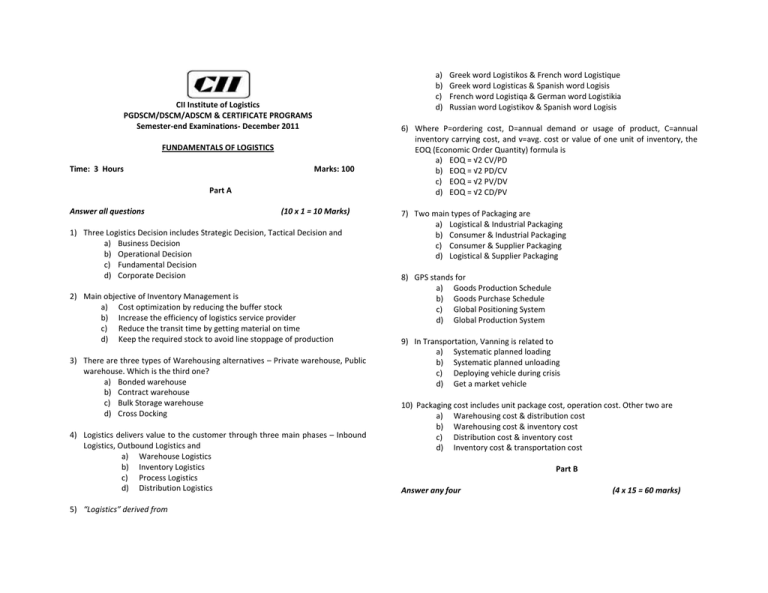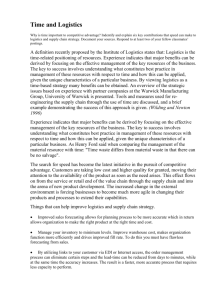Dec 2011 - CII Institute of Logistics
advertisement

a) b) c) d) CII Institute of Logistics PGDSCM/DSCM/ADSCM & CERTIFICATE PROGRAMS Semester-end Examinations- December 2011 FUNDAMENTALS OF LOGISTICS Time: 3 Hours Marks: 100 Part A Answer all questions (10 x 1 = 10 Marks) 1) Three Logistics Decision includes Strategic Decision, Tactical Decision and a) Business Decision b) Operational Decision c) Fundamental Decision d) Corporate Decision 2) Main objective of Inventory Management is a) Cost optimization by reducing the buffer stock b) Increase the efficiency of logistics service provider c) Reduce the transit time by getting material on time d) Keep the required stock to avoid line stoppage of production 3) There are three types of Warehousing alternatives – Private warehouse, Public warehouse. Which is the third one? a) Bonded warehouse b) Contract warehouse c) Bulk Storage warehouse d) Cross Docking 4) Logistics delivers value to the customer through three main phases – Inbound Logistics, Outbound Logistics and a) Warehouse Logistics b) Inventory Logistics c) Process Logistics d) Distribution Logistics 5) “Logistics” derived from Greek word Logistikos & French word Logistique Greek word Logisticas & Spanish word Logisis French word Logistiqa & German word Logistikia Russian word Logistikov & Spanish word Logisis 6) Where P=ordering cost, D=annual demand or usage of product, C=annual inventory carrying cost, and v=avg. cost or value of one unit of inventory, the EOQ (Economic Order Quantity) formula is a) EOQ = √2 CV/PD b) EOQ = √2 PD/CV c) EOQ = √2 PV/DV d) EOQ = √2 CD/PV 7) Two main types of Packaging are a) Logistical & Industrial Packaging b) Consumer & Industrial Packaging c) Consumer & Supplier Packaging d) Logistical & Supplier Packaging 8) GPS stands for a) Goods Production Schedule b) Goods Purchase Schedule c) Global Positioning System d) Global Production System 9) In Transportation, Vanning is related to a) Systematic planned loading b) Systematic planned unloading c) Deploying vehicle during crisis d) Get a market vehicle 10) Packaging cost includes unit package cost, operation cost. Other two are a) Warehousing cost & distribution cost b) Warehousing cost & inventory cost c) Distribution cost & inventory cost d) Inventory cost & transportation cost Part B Answer any four (4 x 15 = 60 marks) 1) What is Logistics? What are the Objectives of Logistics? What is the role of Logistics in Supply Chain Management? What is the Total Cost of managing Logistics Functions? 2) What is the importance of Inventory Management in Logistics & SCM? Do you think various types of stock in inventory really help for better Logistics Management? Explain what the different Inventory Costs are. 3) What are the main drivers of transportation? Explain. Discuss various types of intermodal transportation. What are the successful transportation strategies? 4) What is Logistics Strategy? Explain. What are the strategy options? Discuss Strategic Logistics Planning. Describe the various functions of a warehouse from logistics & supply chain perspective. Identify the various factors that affect the size of the warehouse. How does the warehouse location decision are being taken. 5) 6) What is Global Logistics? Discuss in brief. What documents are required in Global Logistics? What are the problems in International Logistics? Part C Case Study (3*10=30 marks) Personal Care Limited (PCL) is a large and premier FMCG company in India with a turnover of about Rs. 2000 crore. It has 85 production plants spread over the whole country, producing about 120 products ranging from personal care to household goods. The company has of its own warehouse situated in the four zones of north, south, east and west that receive products from almost all the plants on a regular and consignment basis in containers by road. These warehouses are responsible for taking care of stocks, order placement, apart from order processing and transshipment of goods to C&F agents of respective zones whose numbers come around 150 per warehouse. After receiving goods from various plants, these warehousing are first entered into the computer for inventory recording purposes. Suitable storage location spaces are then assigned after taking into consideration the quantity to be stored, the physical dimension, characteristics of items, frequency of flow, and availability of the space, which is quote variable and flexible. For storage of goods , flexible racking system is used so that the size of a rack’s space can be changed as per the size on the product’s package. Furthermore, racking is back-to-back in pallet blocks which are 5 storeyed and in one block, there are about 400 back-to-back rocks. In certain areas, for selected heavy weight and bulky items, 50 selectors drive forklift trucks and in the remaining areas, as many as 350 selectors pick the goods mutually and use hard trolley. Selectors are normally less educated and highly experienced, who have well-defined areas of selection. With this existing system, there have been a lot of practical problems, such as under utilization of space, traffic congestion is aisles between the racks as one selector blocks another’s progress while he is picking items from a location, wrong assortment, difficult to track goods, difficult to fill one single order as it contains a variety of items etc. Furthermore, a trucker is required to collect items from different places of the warehouse to make up the order. Frequently, they have to wait for a full load. Then, the driver had to collect challan and other required papers. Normally, this whole process took seven to ten days, subject to ready availability of the goods in the stock. In the case of stock-out items, it may goes anywhere in between 15 to 30 days. That is why, replenishment cycle time for nearby C&F agents is about 15 days and for others, it comes around 3 weeks. Due to a gradual increase in the quantum of competition and increasing customer expectations, along with increasing awareness about the overwhelming contribution of L&SCM cost reduction and service improvement, the top management of PCL have appointed highly qualified and experienced professionals at all four warehouses with the following objectives: to improve the efficiency of the warehouses; to reduce the replenishment cycle time by 25 per cent; to reduce the total logistical costs by 10 per cent; and to have transparency in dispatch of premium products. Mr. A. K. Sinha, who joined the south zone as chief of warehouse, has had a very successful career of 25 years. He wants to redefine the whole warehouse operating system. Answer the following questions:1. 2. 3. How should Mr. Sinha approach this problem? Develop a strategy to overcome the problem and fulfil the redefined objectives of the firm. What changes would be recommended for the implementation of the new strategy? *****************************************









